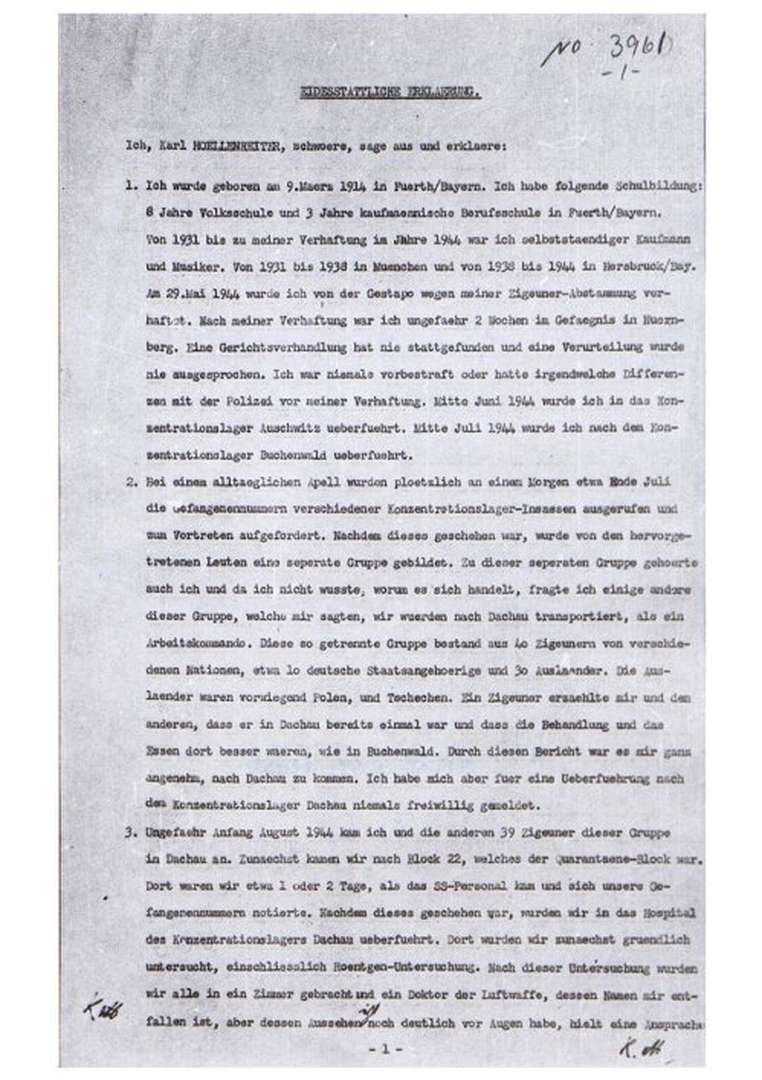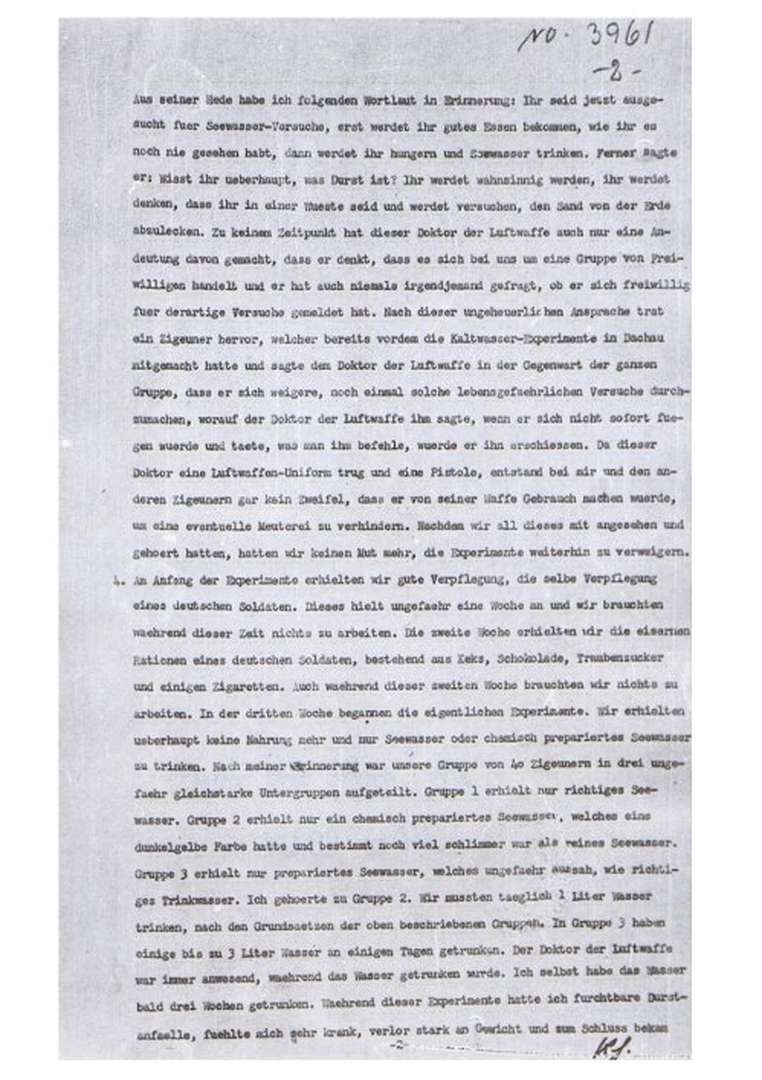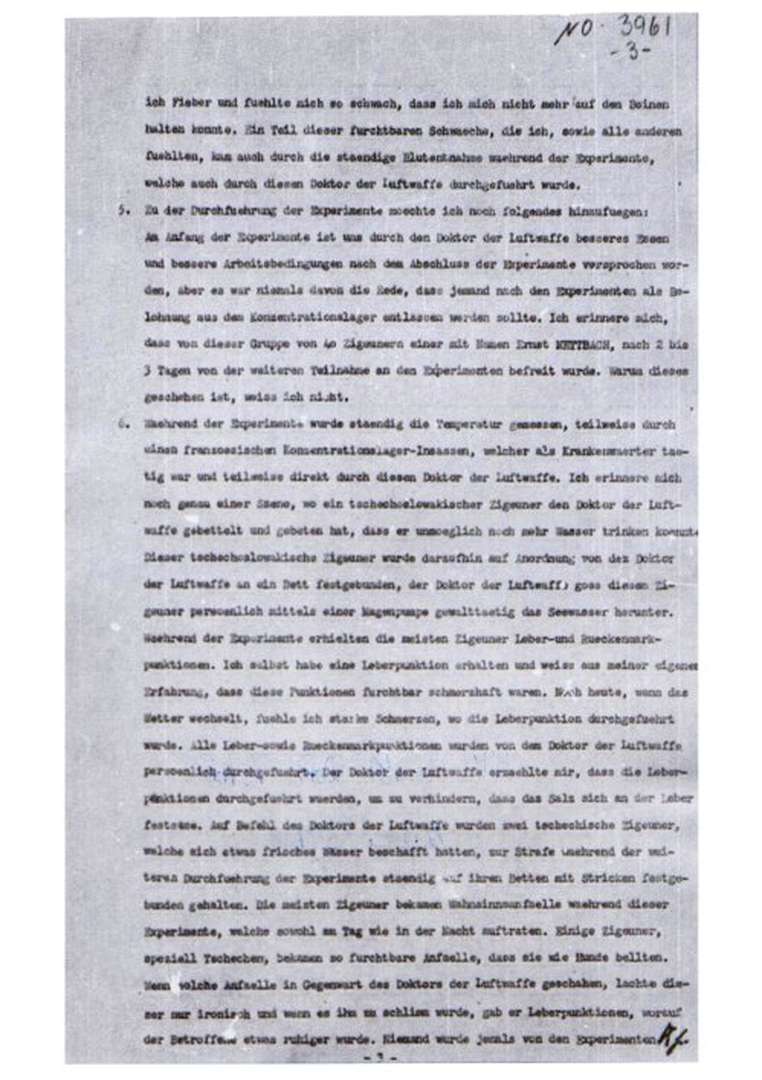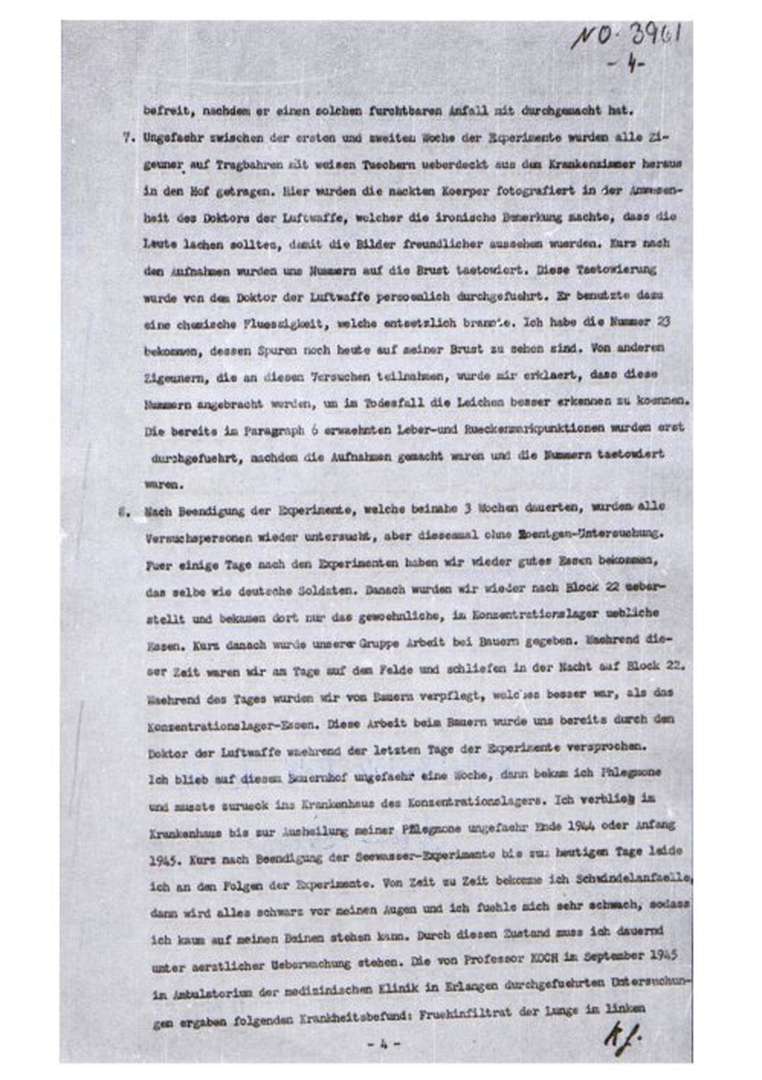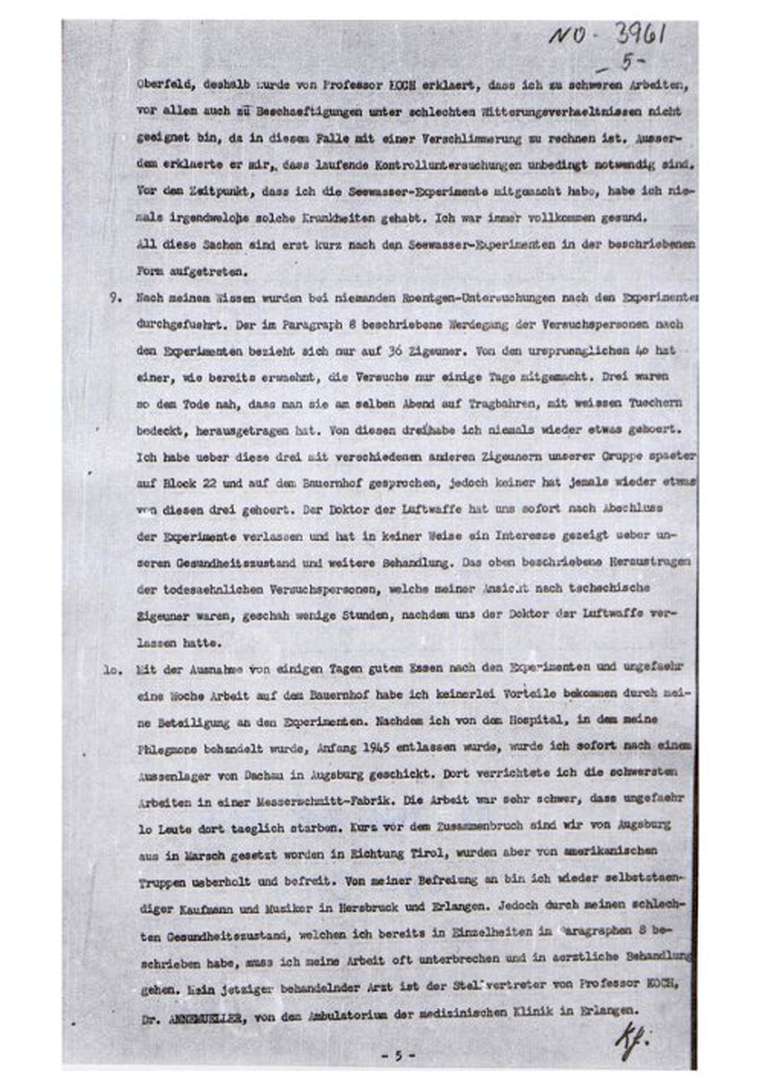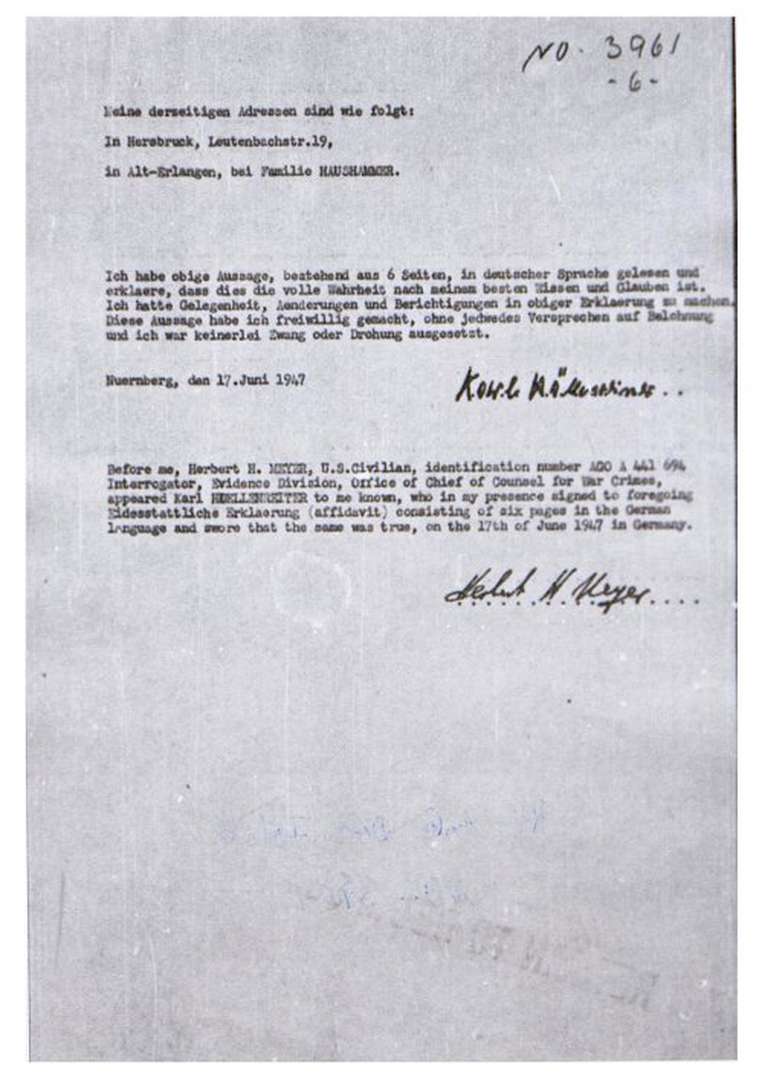NO-3961
-1-
EIDESSTATTLICHE ERKLAERUNG
Ich, Karl HOELLENREINER, schwoere, sage aus und erklaere:
- Ich wurde geboren am 9. Maerz 1914 in Fuerth/Bayern. Ich habe folgende Schulbildung: 8 Jahre Volksschule und 3 Jahre kaufmaennische Berufsschule in Fuerth/Bayern. Von 1931 bis zu meiner Verhaftung im Jahre 1944 war ich selbststaendiger Kaufmann und Musiker. Von 1931 bis 1938 in Muenchen und von 1938 bis 1944 in Hersbruck/Bay[ern]. Am 29. Mai 1944 wurde ich von der Gestapo wegen meiner Zigeuner-Abstammung verhaftet. Nach meiner Verhaftung war ich ungefaehr 2 Wochen im Gefaengnis in Nuernberg. Eine Gerichtsverhandlung hat nie stattgefunden und eine Verurteilung wurde nie ausgesprochen. Ich war niemals vorbestraft oder hatte irgendwelche Differenzen mit der Polizei vor meiner Verhaftung. Mitte Juni 1944 wurde ich in das Konzentrationslager Auschwitz ueberfuehrt. Mitte Juli 1944 wurde ich nach dem Konzentrationslager Buchenwald ueberfuehrt.
- Bei einem alltaeglichen Ap[p]ell wurden ploetzlich an einem Morgen etwa Ende Juli die Gefangenennummern verschiedener Konzentrationslager-Insassen ausgerufen und zum Vortreten aufgefordert. Nachdem dieses geschehen war, wurde von den hervorgetretenen Leuten eine separate Gruppe gebildet. Zu dieser separaten Gruppe gehoerte auch ich und da ich nicht wusste, worum es sich handelt, fragte ich einige andere dieser Gruppe, welche mir sagten, wir wuerden nach Dachau transportiert, als ein Arbeitskommando. Diese so getrennte Gruppe bestand aus 40 Zigeunern von verschiedenen Nationen, etwa 10 deutsche Staatsangehoerige und 30 Auslaender. Die Auslaender waren vorwiegend Polen, und Tschechen. Ein Zigeuner erzaehlte mir und den anderen, dass er in Dachau bereits einmal war und dass die Behandlung und das Essen dort besser waeren, wie in Buchenwald. Durch diesen Bericht war es mir ganz angenehm, nach Dachau zu kommen. Ich habe mich aber fuer eine Ueberfuehrung nach dem Konzentrationslager Dachau niemals freiwillig gemeldet.
- Ungefaehr Anfang August kam[en] ich und die anderen 39 Zigeuner dieser Gruppe in Dachau an. Zunaechst kamen wir nach Block 22, welches der Quarantaene-Block war. Dort waren wir etwa 1 oder 2 Tage, als das SS-Personal kam und sich unsere Gefangenennummern notierte. Nachdem dieses geschehen war, wurden wir in das Hospital des Konzentrationslagers Dachau ueberfuehrt. Dort wurden wir zunaechst gruendlich untersucht, einschliesslich der Roentgen-Untersuchung. Nach dieser Untersuchung wurden wir alle in ein Zimmer gebracht und ein Doktor der Luftwaffe, dessen Namen mir entfallen ist, aber dessen Aussehen ich noch deutlich vor Augen habe, hielt eine Ansprache.
-2-
Aus seiner Rede habe ich folgenden Wortlaut in Erinnerung: Ihr seid jetzt ausgesucht fuer Seewasser-Versuche, erst werdet ihr gutes Essen bekommen, wie ihr es noch nie gesehen habt, dann werdet ihr hungern und Seewasser trinken. Ferner sagte er: Wisst ihr ueberhaupt, was Durst ist? Ihr werdet wahnsinnig werden, ihr werdet denken, dass ihr in einer Wueste seid und werdet versuchen, den Sand von der Erde abzulecken. Zu keinem Zeitpunkt hat dieser Doktor der Luftwaffe auch nur eine Andeutung davon gemacht, dass er denkt, dass es sich bei uns um eine Gruppe von Freiwilligen handelt und er hat auch niemals irgendjemand gefragt, ob er sich freiwillig fuer derartige Versuche gemeldet hat. Nach dieser ungeheuerlichen Ansprache trat ein Zigeuner hervor, welcher bereits vordem die Kaltwasser-Experimente in Dachau mitgemacht hatte und sagte dem Doktor der Luftwaffe in Gegenwart der ganzen Gruppe, dass er sich weigere, noch einmal solche lebensgefaehrlichen Versuche durchzumachen, worauf der Doktor der Luftwaffe ihm sagte, wenn er sich nicht sofort fuegen wuerde und taete, was man ihm befehle, wuerde er ihn erschiessen. Da dieser Doktor eine Luftwaffen-Uniform trug und eine Pistole, entstand bei mir und den anderen Zigeunern gar kein Zweifel, dass er von seiner Waffe Gebrauch machen wuerde, um eine eventuelle Meuterei zu verhindern. Nachdem wir all dieses mit angesehen und gehoert hatten, hatten wir keinen Mut mehr, die Experimente weiterhin zu verweigern.
4. Am Anfang der Experimente erhielten wir gute Verpflegung, die selbe Verpflegung eines deutschen Soldaten. Dieses hielt ungefaehr eine Woche an und wir brauchten waehrend dieser Zeit nichts zu arbeiten. Die zweite Woche erhielten wir die eisernen Rationen eines deutschen Soldaten, bestehend aus Keks, Schokolade, Traubenzucker und einigen Zigaretten. Auch waehrend dieser zweiten Woche brauchten wir nichts zu arbeiten. In der dritten Woche begannen die eigentlichen Experimente. Wir erhielten ueberhaupt keine Nahrung mehr und nur Seewasser oder chemisch pr[ä]pariertes Seewasser zu trinken. Nach meiner Erinnerung war unsere Gruppe von 40 Zigeunern in drei ungefaehr gleichstarke Untergruppen aufgeteilt. Gruppe 1 erhielt nur richtiges Seewasser. Gruppe 2 erhielt nur ein chemisch pr[ä]pariertes Seewasser, welches eine dunkelgelbe Farbe hatte und bestimmt noch viel schlimmer war als reines Seewasser. Gruppe 3 erhielt nur pr[ä]pariertes Seewasser, welches ungefaehr aussah, wie richtiges Trinkwasser. Ich gehoerte zu Gruppe 2. Wir mussten taeglich 1 Liter Wasser trinken, nach den Grundsaetzen der oben beschriebenen Gruppen. In Gruppe 3 haben einige bis zu 3 Liter Wasser an einigen Tagen getrunken. Der Doktor der Luftwaffe war immer anwesend, waehrend das Wasser getrunken wurde. Ich selbst habe das Wasser bald drei Wochen getrunken. Waehrend dieser Experimente hatte ich furchtbare Durstanfaelle, fuehlte mich sehr krank, verlor stark an Gewicht und zum Schluss bekam
-3-
ich Fieber und fuehlte mich so schwach, dass ich mich nicht mehr auf den Beinen halten konnte. Ein Teil dieser furchtbaren Schwaeche, die ich, sowie alle anderen fuehlten, kam auch durch die staendige Blutentnahme waehrend der Experimente, welche auch durch diesen Doktor der Luftwaffe durchgefuehrt wurde.
5. Zu der Durchfuehrung der Experimente moechte ich noch folgendes hinzufuegen: Am Anfang der Experimente ist uns durch den Doktor der Luftwaffe besseres Essen und bessere Arbeitsbedingungen nach dem Abschluss der Experimente versprochen worden, aber es war niemals davon die Rede, dass jemand nach den Experimenten als Belohnung aus dem Konzentrationslager entlassen werden sollte. Ich erinnere mich, dass von dieser Gruppe von 40 Zigeunern einer mit dem Namen Ernst METTBACH, nach 2 bis 3 Tagen von der weiteren Teilnahme an den Experimenten befreit wurde. Warum dieses geschehen ist, weiss ich nicht.
6. Waehrend der Experimente wurde staendig die Temperatur gemessen, teilweise durch einen franzoesischen Konzentrationslager-Insassen, welcher als Krankenwaerter taetig war und teilweise direkt durch diesen Doktor der Luftwaffe. Ich erinnere mich noch genau einer Szene, wo ein tschechoslowakischer Zigeuner den Doktor der Luftwaffe gebettelt und gebeten hat, dass er unmoeglich noch mehr Wasser trinken konnte. Dieser tschechoslowakische Zigeuner wurde daraufhin auf Anordnung von dem Doktor der Luftwaffe an ein Bett festgebunden, der Doktor der Luftwaffe goss diesem Zigeuner persoenlich mittels einer Magenpumpe gewalttaetig das Seewasser herunter. Waehrend der Experimente erhielten die meisten Zigeuner Leber- und Rueckenmarkpunktionen. Ich selbst habe eine Leberpunktion erhalten und weiss aus meiner eigenen Erfahrung, dass diese Punktionen furchtbar schmerzhaft waren. Noch heute, wenn das Wetter wechselt, fuehle ich starke Schmerzen, wo die Leberpunktion durchgefuehrt wurde. Alle Leber- sowie Rueckenmarkpunktionen wurden von dem Doktor der Luftwaffe persoenlich durchgefuehrt. Der Doktor der Luftwaffe erzaehlte mir, dass die Leberpunktionen durchgefuehrt wuerden, um zu verhindern, dass das Salz sich an der Leber festsetze. Auf Befehl des Doktors der Luftwaffe wurden zwei tschechische Zigeuner, welche sich etwas frisches Wasser beschafft hatten, zur Strafe waehrend der weiteren Durchfuehrung der Experimente staendig auf ihren Betten mit Stricken festgebunden gehalten. Die meisten Zigeuner bekamen Wahnsinnsanfaelle während dieser Experimente, welche sowohl am Tag wie in der Nacht auftraten. Einige Zigeuner, speziell Tschechen, bekamen so furchtbare Anfaelle, dass sie wie Hunde bellten. Wenn solche Anfaelle in Gegenwart des Doktors der Luftwaffe geschahen, lachte dieser nur ironisch und wenn es ihm zu schlimm wurde, gab er Leberpunktionen, worauf der Betroffene etwas ruhiger wurde. Niemand wurde jemals von den Experimenten
-4-
befreit, nachdem er einen solchen Anfall mit durchgemacht hat.
7. Ungefaehr zwischen der ersten und zweiten Woche der Experimente wurden alle Zigeuner auf Tragbahren mit weis[s]en Tuechern ueberdeckt aus dem Krankenzimmer heraus in den Hof getragen. Hier wurden die nackten Koerper fotografiert in der Anwesenheit des Doktors der Luftwaffe, welcher die ironische Bemerkung machte, dass die Leute lachen sollten, damit die Bilder freundlicher aussehen wuerden. Kurz nach den Aufnahmen wurden uns Nummern auf die Brust taetowiert. Diese Taetowierung wurde von dem Doktor der Luftwaffe persoenlich durchgefuehrt. Er benutzte dazu eine chemische Fluessigkeit, welche entsetzlich brannte. Ich habe die Nummer 23 bekommen, dessen Spuren noch heute auf meiner Brust zu sehen sind. Von anderen Zigeunern, die an diesen Versuchen teilnahmen, wurde mir erklaert, dass diese Nummern angebracht wurden, um im Todesfall die Leichen besser erkennen zu koennen. Die bereits in Paragraph 6 erwaehnten Leber- und Rueckenmarkpunktionen wurden erst durchgefuehrt, nachdem die Aufnahmen gemacht waren und die Nummern taetowiert waren.
8. Nach Beendigung der Experimente, welche beinahe 3 Wochen dauerten, wurden alle Versuchspersonen wieder untersucht, aber dieses mal ohne Roentgen-Untersuchung. Fuer einige Tage nach den Experimenten haben wir wieder gutes Essen bekommen, das selbe wie deutsche Soldaten. Danach wurden wir wieder nach Block 22 ueberstellt und bekamen dort nur das gewoehnliche, im Konzentrationslager uebliche Essen. Kurz danach wurde unserer Gruppe Arbeit bei Bauern gegeben. Waehrend dieser Zeit waren wir am Tage auf dem Felde und schliefen in der Nacht auf Block 22. Waehrend des Tages wurden wir vom Bauern verpflegt, welches besser war, als das Konzentrationslager-Essen. Diese Arbeit beim Bauern wurde uns bereits durch den Doktor der Luftwaffe waehrend der letzten Tage der Experimente versprochen. Ich blieb auf diesem Bauernhof ungefaehr eine Woche, dann bekam ich Phlegmone und musste zurueck ins Krankenhaus des Konzentrationslagers. Ich verblieb im Krankenhaus nur bis zur Ausheilung meiner Phlegmone ungefaehr Ende 1944 oder Anfang 1945. Kurz nach Beendigung der Seewasser-Experimente bis zum heutigen Tage leide ich an den Folgen der Experimente. Von Zeit zu Zeit bekomme ich Schwindelanfaelle, dann wird alles schwarz vor meinen Augen und ich fuehle mich sehr schwach, sodass ich kaum auf meinen Beinen stehen kann. Durch diesen Zustand muss ich dauernd unter aerztlicher Ueberwachung stehen. Die von Professor KOCH im September 1945 im Ambulatorium der medizinischen Klinik in Erlangen durchgefuehrten Untersuchungen ergaben folgenden Krankheitsbefund: Fruehinfiltrat der Lunge im linken
-5-
Oberfeld, deshalb wurde von Professor KOCH erklaert, dass ich zu schweren Arbeiten, vor allem auch zu Beschaeftigungen unter schlechten Witterungsverhaeltnissen nicht geeignet bin, da in diesem Falle mit einer Verschlimmerung zu rechnen ist. Ausserdem erklaerte er mir, dass laufende Kontrolluntersuchungen unbedingt notwendig sind. Vor dem Zeitpunkt, als ich die Seewasser-Experimente mitgemacht habe, habe ich niemals irgendwelche Krankheiten gehabt. Ich war immer vollkommen gesund. Alle diese Sachen sind erst kurz nach den Seewasser-Experimenten in der beschriebenen Form aufgetreten.
9. Nach meinem Wissen wurden bei niemandem Roentgen-Untersuchungen nach den Experimenten durchgefuehrt. Der im Paragraph 8 beschriebene Werdegang der Versuchspersonen nach den Experimenten bezieht sich nur auf 36 Zigeuner. Von den urspruenglichen 40 hat einer, wie bereits erwaehnt, die Versuche nur einige Tage mitgemacht. Drei waren so dem Tode nah, dass man sie am selben Abend auf Tragbahren, mit weissen Tuechern bedeckt, herausgetragen hat. Von diesen drei habe ich niemals wieder etwas gehoert. Ich habe ueber diese drei mit verschiedenen anderen Zigeunern unserer Gruppe spaeter auf Block 22 und auf dem Bauernhof gesprochen, jedoch keiner hat jemals wieder etwas von diesen drei gehoert. Der Doktor der Luftwaffe hat uns sofort nach Abschluss der Experimente verlassen und hat in keiner Weise ein Interesse gezeigt ueber unseren Gesundheitszustand und weitere Behandlung. Das oben beschriebene Heraustragen der todesaehnlichen Versuchspersonen, welche meiner Ansicht nach tschechische Zigeuner waren, geschah wenige Stunden, nachdem uns der Doktor der Luftwaffe verlassen hatte.
10. Mit der Ausnahme von einigen Tagen gutem Essen nach den Experimenten und ungefaehr eine Woche auf dem Bauernhof habe ich keinerlei Vorteile bekommen durch meine Beteiligung an den Experimenten. Nachdem ich von dem Hospital, in dem meine Phlegmone behandelt wurde, Anfang 1945 entlassen wurde, wurde ich sofort nach einem Aussenlager von Dachau in Augsburg geschickt. Dort verrichtete ich die schwersten Arbeiten in einer Messerschmitt-Fabrik. Die Arbeit war sehr schwer, dass ungefaehr 10 Leute dort taeglich starben. Kurz vor dem Zusammenbruch sind wir von Augsburg aus in Marsch gesetzt worden in Richtung Tirol, wurden aber von amerikanischen Truppen ueberholt und befreit. Von meiner Befreiung an bin ich wieder selbststaendiger Kaufmann und Musiker in Hersbruck und Erlangen. Jedoch durch meinen schlechten Gesundheitszustand, welchen ich bereits in Einzelheiten im Paragraphen 8 beschrieben habe, muss ich meine Arbeit oft unterbrechen und in aerztliche Behandlung gehen. Mein jetziger behandelnder Arzt ist der Stellvertreter von Professor KOCH, Dr. ANNEMUELLER, von dem Ambulatorium der medizinischen Klinik in Erlangen.
-6-
Meine derzeitigen Adressen sind wie folgt:
In Hersbruck, Leutenbachstr. 19,
in Alt-Erlangen, bei Familie HAUSHAMMER.
Ich habe die obige Aussage, bestehend aus 6 Seiten, in deutscher Sprache gelesen und erklaere, dass dies die volle Wahrheit nach meinem besten Wissen und Glauben ist. Ich hatte Gelegenheit, Aenderungen und Berichtigungen in obiger Erklaerung zu machen. Diese Aussage habe ich freiwillig gemacht, ohne jedwedes Versprechen auf Belohnung und ich war keinerlei Zwang oder Drohung ausgesetzt.
Nuernberg, den 17. Juni 1947
Karl Höllenreiner [Unterschrift]
Before me, Herbert H. MEYER, U.S. Civilian, identification number AGO A 4412 694 Interrogator, Evidences Division, Office of Chief of Counsel for War Crimes, appeared Karl HOELLENREITER [sic] to me known, who in my presence signed to foregoing Eidesstattliche Erklaerung (affidavit) consisting of six pages in the German language and swore that the same was true, on the 17th of June 1947 in Germany.
Herbert H. Meyer [Unterschrift]




